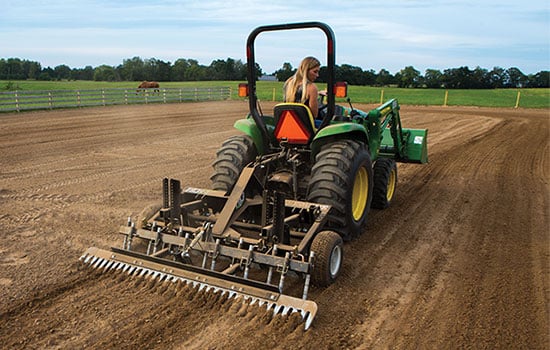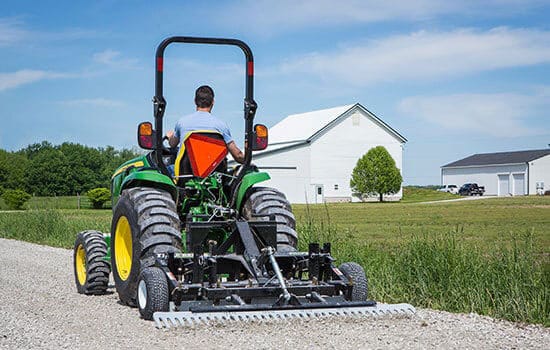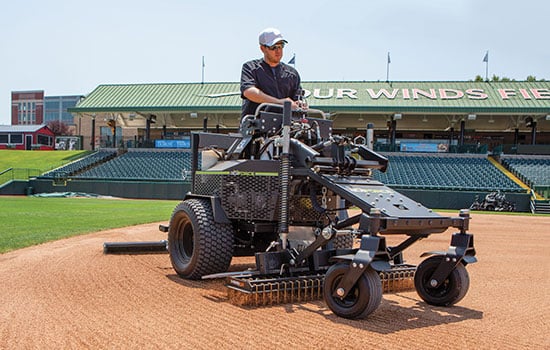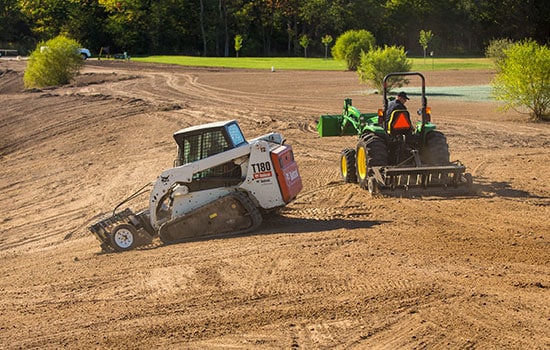Paddock Cleanup and Pasture Care
Leveling Out A Pasture
Matt joins ABI’s Director of Engineering, Nate Smith, at his home property for an afternoon project of getting the cattle paddock cleaned up and doing some routine pasture care. With the TR3, Nate is able to get through manure build up, break up dirt clods, and prepare bare spots for seeding so he can turn his calves out safely into the pasture for summer.
ABI Products Shown In This Video
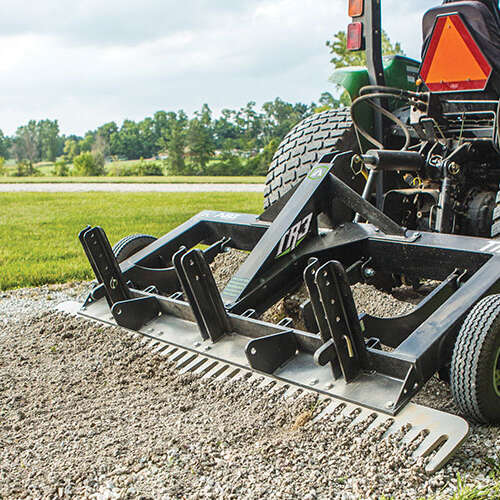
TR3 Rake
- For Compact & Utility Tractors
- 6.5', 7.5', 8.5', 10' Widths - Commercial-Duty
- Starting At: $116/mo.*
Transcript
Paddock Maintenance
Hi everyone. Matt here with ABI Attachments. We’ve got a really fun episode here on “The ABI Dirt”. I get to introduce you to someone that I’ve been really wanting to introduce you to for a long time now. And that’s our friend, Nate Smith. Nate is our director of product development and engineering here at ABI Attachments. He is the brain muscle behind some of your favorites, some of our favorite attachments, the SR3, the gravel grader the TR3 E-series and all of its versions. That’s all been Nate as the primary designer on those. So Nate, you’ve been with us nine years now.
– Yep. Just over nine years.
– So another reason we love hanging out with Nate is because not only does he love designing tools to work in the dirt, he loves being in the dirt. This is actually his farm. How long have you been on site here?
– So we bought this place just over two years ago doing a lot of restoration work, 1200 feet of driveway, just over seven acres.
– So there’s lots to do.
– And luckily we make the tools that helps take care of projects like this.
– I would love coming over to Nate’s place and working in the dirt, actually, when it comes to inventing something new, you have to take the time to test it which means you get to try to break it every now and then. So we love coming to Nate’s place seeing if we can break stuff, but we’re out here for a specific project today. Typically a spring project around the farm, Nate, what are we doing? What are we working on?
– We raise dairy feeder steers which are about ready to go to butcher actually, then I have the little calves, this year’s 4H project that we need to turn out into the pasture. The problem is the area where I enclosed them over the winter is really rough because we’re in high clay soils, very poor pasture drainage. We just really struggle as far as trying to manage the pasture for its own health. I need to use the implement to level this pasture back out in order to allow the steers to safely navigate across it basically.
– And I know a lot of you had the same experience that you’re trying to throw some feed out or throw the hay bales out in the paddock area and you’re twisting your ankles all along the way.
Best Implement to Level a Pasture
So what are the steps to the process?
– So we’re gonna be using a little bit bigger 60 horse tracker with a seven foot TR3 between the rake and the level bar. I’m gonna be able to level out this area. I’ll use some rippers to rip it up some. I also wanna move some material around just to help improve that pasture drainage situation some. Just trying to fix up the muddy mess that has since dried out.
– And before we jumped on camera here, what are some of the the prep steps that you took in order to prepare in order to put the tool on the ground?
– So I’ve pulled out all those obstacles. I’m gonna get rid of this hay feeder here. And then we just, yeah, keep your animals out of the way. And we’re gonna set, we’re gonna probably go heavy rake at first just to see what we can do to level. I’m cheating a little bit that I’m using a hydraulic top link that is a really nice option because it’s gonna let me alternate between rake and ripping very handy. I don’t need to rip it up. It’s fairly loose. But as I pack it down with a rake, cause the Rake’s gonna pack, then I will have to alternate and rock back on the scarifiers, probably to rip back up just to get the material movement where I want it. I’m also probably gonna start out with my level bar pinned up pretty high. Because it’s just so loose and so bumpy, it’s gonna take a couple passes just to where then I can put that level bar into play more just to kind of fill the bigger holes first will be the primary mission here.
– So let’s get to work.
How to Smooth a Rough Pasture
– So here’s my paddock that I have to work on. As you can see, this is where my feeder was sitting. So I have a big mound of material where the steers just churned it up. I mean, this was foot deep mud in the wettest of spring. So we gotta level this back out, pull this back down because it’s just gonna act as a dam to hold drainage. It’s just gonna get worse and worse. The other thing that I’m just generally managing here is if you look out at my pasture, I got different levels, different areas are grazed at different heights. That’s because I’m relationally grazing them for the soil health. I’m moving them around every day or every couple days. And so by leveling this out, then I can introduce my smaller steers that are about three months old now to get out here and help graze as well. I have a couple dead spots that were created generally due to a feeder that sat there or a poor paddock drainage area. So like this spot over here, I wanna reseed. So to reseed that, I am going to take the scarifiers on the tool and rip it up to drain it better. And the rake then with our seeding is gonna give us much better seed to soil contact so that we can have this come back successfully. I’m gonna start out by pinning this level bar up. Cause we got plenty of material to level up and I’m just gonna try to pull it with a rake first. So like I said, this tractor has a hydraulic top link, so I’ll be able to play it out, play heavy rake.
– Now it’s worth mentioning, and I know Nate’s already mentioned it a couple of times we have a hydraulic cylinder on this tractor right now. You’ve heard me mention the hydraulic cylinder ad nauseum here in “The Dirt” how much we appreciate hydraulic cylinder, how easy it is. So when you see Nate here in a little bit going kind of button down, raking down on this TR3, that’s only possible with all the maneuvering he’s doing because the hydraulic cylinder. So keep a close eye there on all of the pitch change. That’s the magic of that hydraulic cylinder and why we really encourage you to pick one up when you pick up a TR3. You’ll also see in the back of this tractor a quick attach and that’s something that we’ve got on this unit. If you don’t swap attachments out a lot on your property, if you only have kind of one go to, you might not need it but around the farm here and then around the ABI, we’ve definitely used that quick system. So Nate, you said originally your hope was that you could actually tote the rake kind of rear down, grab the finish rake and use the rake to pull material out. But after just a couple of passes, I see you jump off the tractor. So what adjustments are you making? I’m actually gonna use it more like a box blade where I put these pins in to lock it down because then I’m just gonna be able to carry the material. It’s kind of gooey, kind of slimy. I’ll admit it’s a little bit of manure, but it’s okay. Our tools are tough enough to handle that and I can adjust the conditions as they present. And if you’ve been following “The Dirt” any length of time, you know that we had a long episode specifically on the low blade of the TR3 not so long back. So check that one out if you haven’t seen it, but that level blade in the middle of the TR3 floats quite a bit. So if we can lock it down, like you said, hopefully we can use that as a box blade and we’ll see where it goes.
Pasture Drainage Solutions
– Now that we’ve knocked off the slick wet stuff, as we work towards the dry end of things, it’s much more crusty and I gotta break it up. I also want to cut into this mound right here a little bit to fix my pasture drainage. So I’m gonna actually flip over and put these scarifiers in and set them fairly deep. Because again, with the hydraulic top link, I can change the angle and change that aggressiveness.
– Nate, this looks great, man. So you knocked off the high spots, decompacted the scarifiers, took care of a lot of your clouds on the finish rake, loosened up your low wet spot over there, what’s next?
How to Seed a Pasture
– Well, honestly it’s all seed. I mean, it’s ready to throw seed on. I’ll probably con my kids into helping run the cold packer on it to pack the seed in and water it in real good here because it’s actually pretty dry and loose and yeah. Hopefully we can keep the cows off there long enough to grow some grass in this section back here for next winter.
– Right on. Well, that’s all we’ve got today for everyone as far as this episode of “The Dirt”. Nate, appreciate you taking the time. You’re gonna see more of Nate now that he’s been here on “The Dirt”, we want to have him back and ask him a couple more questions, work on some projects with him, but until next time everyone, take care.
